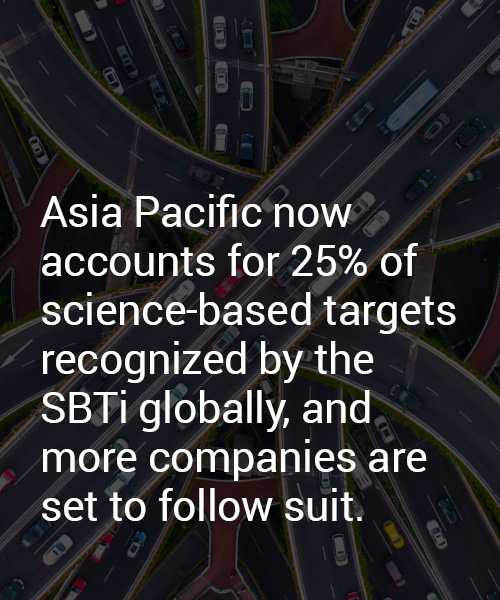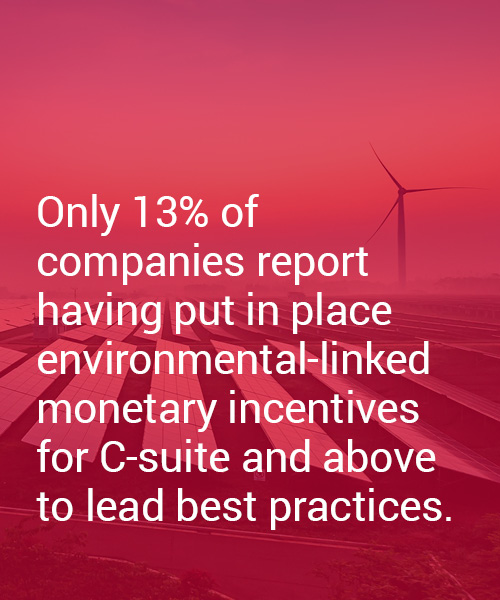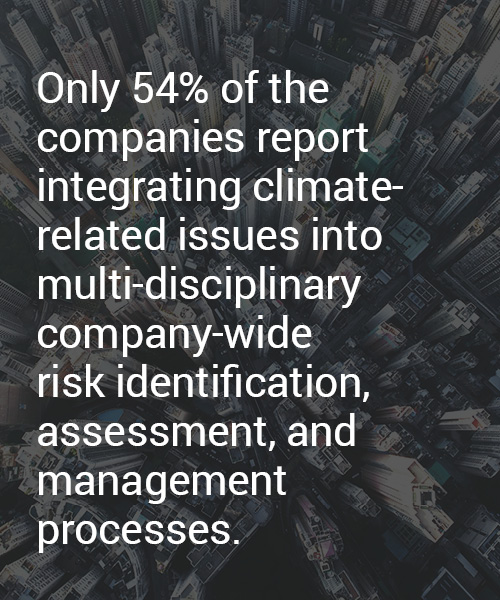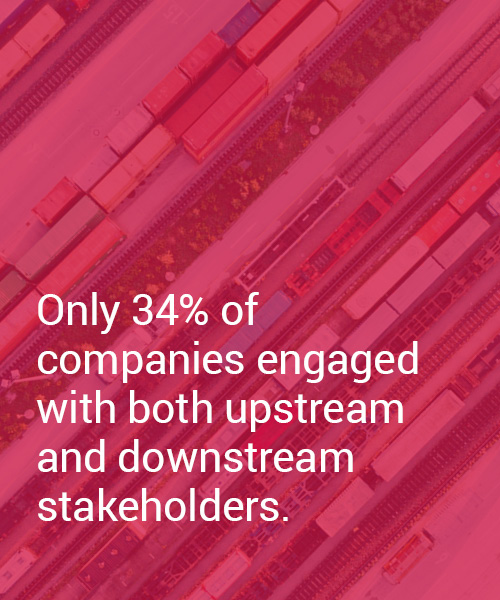Home to the world’s fastest growing economies and considered one of the most vulnerable regions to the adverse impacts of climate change, the Asia Pacific region must rise to the challenges of low-carbon transition. Despite increased awareness of climate-related risks, companies and cities in the region have yet to put in place the comprehensive initiatives necessary to meet targets in line with the Paris Agreement.
2,511 companies in the Asia Pacific region (APAC) responded to CDP’s climate change questionnaire in 2019. This dynamic report analyzes the climate-related risks and opportunities reported by companies, in line with the recommendations from the Task Force on Climate-related Financial Disclosures (TCFD).
By aligning the analysis with the 4 core elements stipulated by TCFD, namely Governance, Strategy, Risk Management, and Metrics and Targets, the report identifies key trends and progress on corporate climate action at the regional level, as well as the challenges in ramping up ambition, increasing transparency, and adopting best practices.
Companies must step up their climate commitments, fast
Our 2019 findings reveal that while companies in the Asia Pacific region are increasingly aware of the actions needed to address climate-related risks, the mechanisms currently in place are not comprehensive enough to achieve a low-carbon pathway in line with the Paris Agreement goals:

Many companies follow best practices on dealing with climate change: 79% of the companies report having board-level oversight of climate-change issues and 74% report integrating climate change into their business strategy. However, only a narrow majority of companies (54%) integrate climate-related issues into company-wide risk management process, and just 40% follow all three of these best practices, indicating room for improvement in terms developing a comprehensive strategy to accelerate the low-carbon transition.
In a similar vein, the next chart suggests that in order to achieve sustainable transition, companies in the region need to step up their current level of initiatives on various fronts, such as target setting and value chain engagement. Our data reveals that 68% of disclosing companies have at least one emission target (absolute or intensity target), however companies are having mixed results achieving these targets.
Governance

The current level of board-level oversight on climate-related issues across the region suggests that a significant majority of companies are set to manage climate-related risks and opportunities. However, only 13% of companies have monetary incentives in place – such as a bonus or some other form of financial remuneration – for at the C-suite level or above that are tied to establishing environmental projects or targets including emissions reductions, energy saving, or supply chain engagement, which CDP considers the best practice.
To ensure such climate-related initiatives are prioritized and implemented to effectively yield results, companies should set monetary or other measurable incentives to achieve targets throughout their organizational management. As the organizational cultures in many countries in Asia Pacific are more inclined to be vertical and top-down, it is vital that environmental action is led from the top, with strong incentives being not just a key indicator of a company’s commitment to climate action, but also a catalyst.
Risks and Opportunities
Nearly 74% in our Asia Pacific dataset reported having an integrated process in place for identifying, assessing and managing climate-related issues in overall risk management. This may be attributed to the emerging regulatory development for Environmental, Social, and Governance (ESG) disclosures in the region.
Of the risks identified, 56% are transition risks and the most common are policy and legal-related, such as increased pricing of GHG emissions, regulations on existing products and services, as well as enhanced emissions-reporting obligations.

Among physical risks, the most cited business risks are increased severity of weather events such typhoons and floods. For example, an infrastructure company in the Greater China region reported excessive rains and flooding which impacted their operations and limited its construction activities on site, causing potential project delay and increased costs.
This growing awareness of acute physical risks is also driven by the region’s disaster-prone nature. Asia Pacific - home to 60% of the world's population - has been considered one of the most vulnerable regions to the adverse impacts of climate change. A UN report published in August 2019 estimates that the annual economic loss from growing disasters (including those triggered by climate change and environmental degradation) for the region has reached $675 billion, or around 2.4% of the region’s GDP.
Despite the widespread recognition that urgent climate action is required to address these risks, our findings reveal gaps between companies’ climate assessments and their integration into wider business operations. For example, although a majority of the companies (74%) confirmed they have a climate-risk process in place, only half of all companies (54%) reported an active integration of climate-related issues into multi-disciplinary company-wide risk identification, assessment, and management processes, which we consider to be the best practice.
Opportunities identified:
Meanwhile, companies have also started to look at opportunities associated with proactive responses to climate change. Almost 70% of companies are now aware of the financial or strategic value of climate-assessments as they identify business opportunities arising from the transition to a low carbon economy.
The most commonly reported opportunities related to development new products and services (e.g. low-carbon products); improving resource efficiency; and identifying new energy sources. We believe this is an especially positive sign as companies are moving beyond risk management and tapping into the financial opportunities from a low-carbon transition.
Business Strategy
CDP is committed to enhancing the transparency of potential financial impacts of climate change in order to drive more informed and sustainable decision-making within the business and finance community. We continue to work with our 515 investor signatories to provide comprehensive disclosure data, including companies’ forward-looking statements on climate-related risks and opportunities. Scenario analysis therefore becomes a vital tool in this regard as it can aid investors, lenders, and insurance underwriters in informing their own financial decision-making.
In 2018 and 2019, about half (51%) of the APAC companies reported using climate-related scenario analysis to inform their business strategies. On the sub-region level, the region comprising Australia and New Zealand have the highest rate (58%) of companies that report using scenario analysis, followed by companies in Southeast Asia (53%), suggesting an emerging leadership across the sub-regions in APAC.
As with increased management of climate risks, we expect more companies in the region to start integrating scenario analysis into business planning to better understand the strategic implications for a low-carbon transition. Our analysis shows that even among the companies in Asia Pacific that are not currently using scenario analysis in their business strategy, 34% are anticipating doing so within the next 2 years.
Value chain engagement
Question C12.1: Do you engage with your value chain on climate-related issues?
CDP’s prior analysis reveals that supply chain emissions are on average 5.5 times higher than a company’s directly accountable emissions. This makes multi-stakeholder engagement across the value chains critical in achieving global net-zero GHG pathway.

Our regional findings show that, while over 70% of companies report including their supply chains within their climate-risk assessments, there remains a considerable gap when it comes to companies engaging with both their upstream and downstream stakeholders with respect to overall climate-related issues, including risks.
Among the companies engaging with their value chain in APAC, only 34% engaged with both upstream (suppliers) and downstream (customers) stakeholders. To date, 16% of companies have taken the additional step of creating a verification process for their Scope 3 emissions, enabling the opportunity to better monitor and manage the whole range of emissions associated with their operations.
Furthermore, 29% of companies in APAC neither engage with their upstream nor downstream stakeholders, and nearly 20% of these companies report they do consider their value chains relevant to climate risks but have yet to include or evaluate them in their risk assessments.
At CDP, we consider the value chain a critical aspect of engagement and encourage further action from companies in leveraging their purchasing power and collaborating with their supply chains. By doing so, companies can ensure their climate ambitions cascade upstream.
Targets and Metrics

Our analysis of 2019 data also points to the need for more holistic actions from companies in terms of meeting targets and improving environmental performance. Target setting provides direction and structure to a company’s overall environmental strategy, and the information involved is also highly relevant to investors and other data users to understand how companies are addressing and monitoring progress regarding climate-related risks and opportunities.
Although 68% of companies in our regional dataset report having emission targets, only 36% in APAC reported a year-on-year decrease in Scope 1 and 2 emissions. Moreover, only 25% of companies have third party verification in place to audit their scope 1 and 2 emissions, whereas 7% did not provide any relevant emissions data.
Despite a positive 100% year-on-year increase in overall validated targets in the region, we also see a disproportionately distributed trend among the companies that align their business models to the Paris Agreement. For instance, out of 43 companies in the Asia Pacific committed to science-based targets (SBTs), as many as 23 are from Japanese and Indian companies. For Japan, this commitment has been primarily policy driven, where the government has enacted regulatory support for companies setting SBTs as part of Japan’s long-term climate and growth strategy.
A further 15% of the targets can be found in India, which saw a spike in SBT uptake after the Mahindra Challenge in 2018. Japan and India are cases in point that demonstrate the importance of having enabling policy framework to drive enhanced corporate climate action. At the same time, many companies in APAC, including the highest emitters in the region such as China, Bangladesh, Thailand, Malaysia and South Korea, are yet to either set commitments or to have validated targets.
The “climate decade” also brings opportunities to the region
At CDP, we intend to step up engagement with companies with respect to their science-based targets and will continue to provide support to companies in this regard. Over the course of this year, we will be hosting a series of workshops and webinars to assist interested companies in the region in developing a better understanding of the SBT methodologies and verification process.
2020 marks the start of a critical decade for accelerating actions to avoid the worst impacts of climate change. Through our data, the world’s largest comprehensive set available, CDP continues to track the progress and inform decisions on climate action from companies, investors, and cities. Ambition and capacity gaps must be bridged in order to translate assessments and strategies into action-oriented goals.
